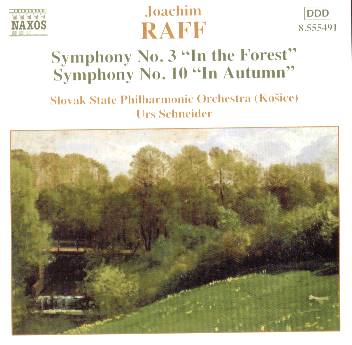In Walde was the third of Raff’s eleven symphonies
and dates from the decade or so after he had finally unshackled himself
from his role in the circle of Franz Liszt in which he claimed inter
alia, maybe with some justification, to have been responsible for
orchestrating Prometheus and Tasso. In Walde was
written in 1869 and is couched in four movements written in three parts
– Part 2 is divided into two movements – each with a poetic superscription
in echt Romantic tradition. Despite its explicitly programmatic affiliations
and its exploration of that locus classicus of German Romanticism, the
Forest, the work remains fundamentally enjoyable purely in strict symphonic
terms.
This disc was first issued on Marco Polo 8.223321 in
1991 and is another in Naxos’s budget price reissues. For the recording
the Slovak State Philharmonic was engaged, the principal orchestra in
the east of the country, under Urs Schneider. He certainly takes a measured
view of the opening Allegro and whilst it’s not without momentum it’s
without ostensible drive. There are some admirable orchestral contributions
– chirpy woodwind (in the best and most august Czech-Slovak tradition),
saturnine bassoon, some fine lower strings. Even without the generation
of vitesse Schneider does justice to the refinement and delicacy of
much of the orchestration and to the frequently sharp rhythmic snap
of the writing. The first movement of the second part, In der Dämmerung
and Träumerei, receives eloquent address from orchestra
and conductor. The firmly moving expression of the music is well conveyed
even if there is ultimately here an ultimate want of real lyrical intensity.
The Dance of the Dryads – which comprises that second part –
is very reminiscent of the scherzo from Mendelssohn’s A Midsummer
Night’s Dream; the Dryads are certainly less clod-hopping than in
the comparable Ghost’s Dance in the Tenth Symphony (see below)
and they are accompanied by rustic flute chirrups and much woodwind
chatter. Especially admirable is the impressive bassoonist’s delightful
line and the long breathed string melody. The finale (At Night)
is dramatic, trumpet punctuated and driving, full of hunting allegory
and mythological allusion but I’m afraid there seems to be a large cut
here, not noted in the booklet. The wrong tracking is a more minor problem
- there are eight tracks listed but only seven play thus conflating
the Dryad’s Dance and Finale and confusing everything
but this is a relatively minor matter. The excision is serious.
The Tenth Symphony was written a decade later
in 1879, subtitled In Autumn. Scheider takes the opening of the
four movements at a good swinging Allegro moderato, with nice
orchestral attacks and emphases, the winds verdant and a real sense
of autumnal anticipation. In the Ghost’s Dance the billowing
double basses announce the appearance of the spectres – which at this
moderate tempo are more benevolent and sleepy than malevolent and saturnalian.
The heart of the Tenth is the beautiful Elegie-Adagio. It unfolds
here with eloquent expressivity, with simplicity and with direction,
the rise and fall of the lyric line handled with significant intensity
and skill by Schneider and the orchestra responding with more than usual
delicacy. Die Jagd announces a hunting finale – horns and chase
punctuated by moments of relaxation and reflectiveness in the affectionate
second subject. The oboist laces an exquisite solo followed by flute
tracery before the hunt collects itself once more and drives away to
a dynamic conclusion.
I’m not quite sure where this leaves us. I enjoyed
the disc very much but the cut in the finale of the Third is a real
problem (and I don’t think it was necessary to fit the symphonies on
one disc, I rather think it was made for structural reasons by Schneider).
If you can live with it, fine; if not look elsewhere, but I’d certainly
recommend the Tenth. There’s some slight congestion and a rather backward
sound picture generally when it comes to recording quality but that’s
not problematical. Over to you.
Jonathan Woolf

